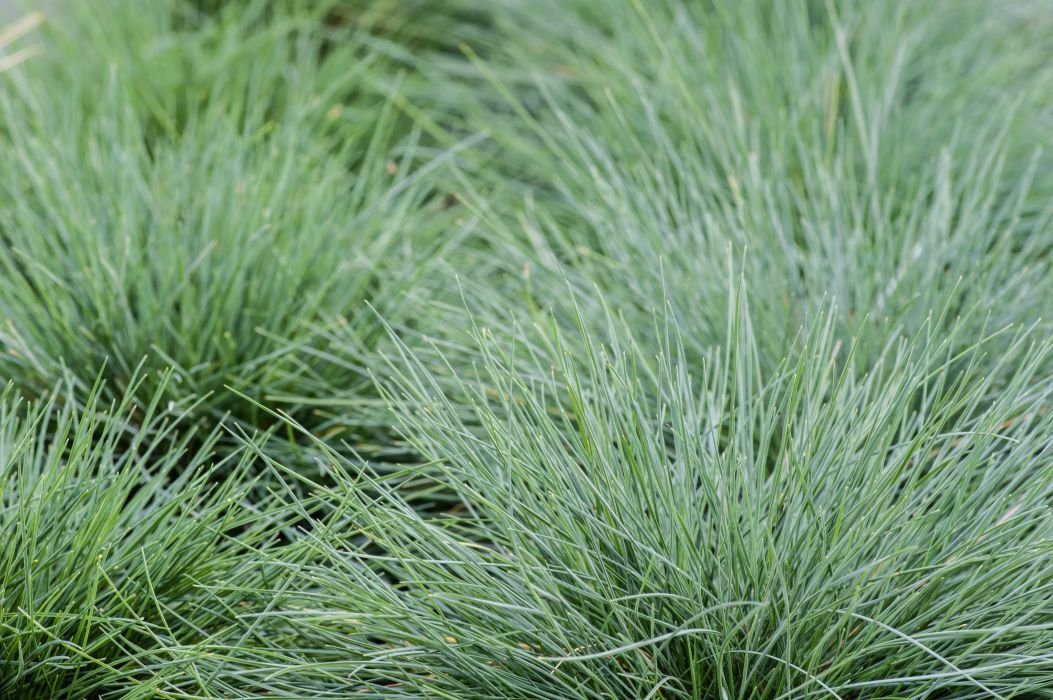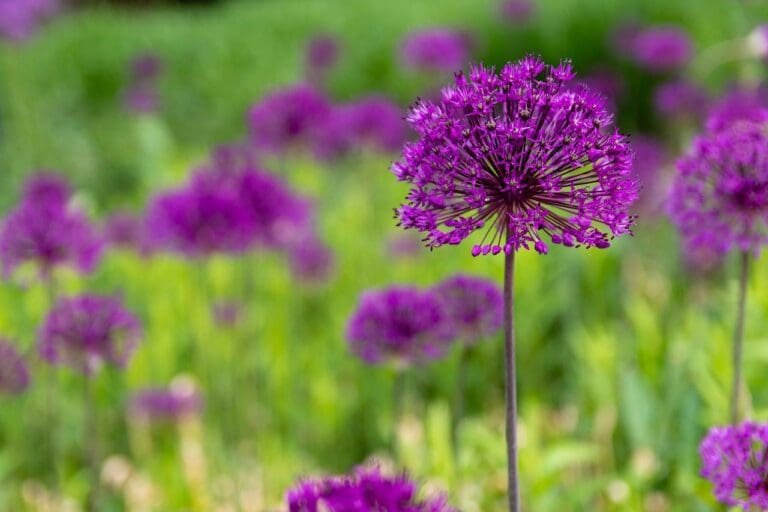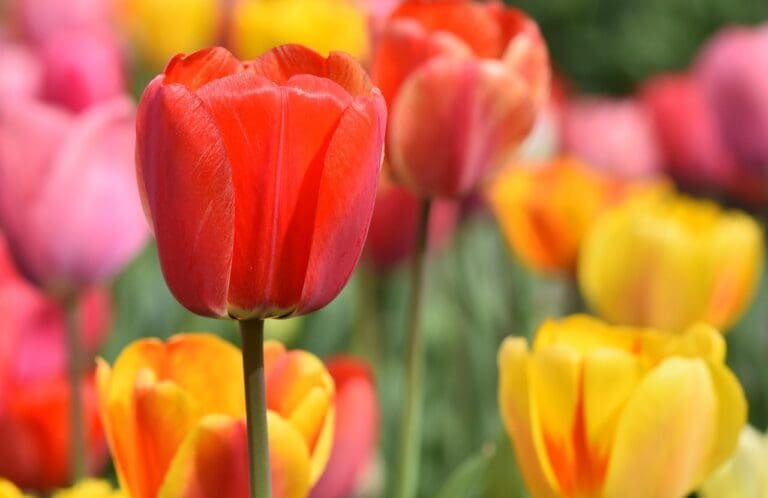Festuca glauca, commonly known as blue fescue, is a popular ornamental grass grown for its distinctive blue-green foliage. This clump-forming grass features fine, needle-like leaves that form an eye-catching dense tuft or mound shape. With its cool-coloured foliage and pleasing texture, Festuca glauca adds visual interest and colour contrast to gardens and landscapes.
Unlike many ornamental grasses, blue fescue remains compact and tidy, typically reaching 8-12 inches in height and 12-18 inches in width. It can fit well in rock gardens, borders, containers, and more, adapting to various conditions. Blue fescue’s neat form and low maintenance needs make it a go-to choice for gardeners looking to incorporate ornamental grasses into the landscape.
You might also like: Ornamental Grasses
Festuca Glauca Care and Growing Guide
Caring for blue fescue grass is relatively simple, as it is quite tolerant of poor soils and drought once established. Here is a look at how to plant and grow this attractive grass successfully:
Planting
Festuca glauca can be planted in spring or fall, avoiding the heat of summer. Select a site with full sun exposure for best growth and to bring out the blue foliage. Well-draining soil is recommended, so amend clay or sandy soils with organic matter like compost before planting.
Space plants 12-18 inches apart in the garden. Dig holes twice as wide and just as deep as the root ball. Carefully remove plants from containers, loosen bound roots, and place in holes. Backfill with soil, firming it around the base. Water thoroughly after planting.
Other planting tips include:
- Removing any dead leaves or spent grass before planting
- Watering the roots but avoiding wetting the foliage
- Adding a 2-inch layer of mulch around plants to retain moisture
Watering
Blue fescue prefers consistent moisture after planting to establish. Water plants regularly the first few months. Once mature, it is quite drought tolerant and requires little watering except in very dry periods.
Festuca glauca foliage will turn brown at the tips when overly dry. On the other hand, soggy soil can cause root rot. Allow the soil to partially dry out between waterings for best results. Deep weekly soakings are better than frequent light watering.
Signs of underwatering:
- Foliage browning at tips and edges
- Wilting or drooping leaves
- Poor or stunted growth
Overwatering may cause:
- Foliage yellowing
- Dead leaves
- Black rotten roots
Lighting
Blue fescue thrives in full sun, where it will produce the richest blue-gray foliage colour. At least 6 hours of direct sunlight daily is ideal. It also tolerates light shade, but may become greener and less compact.
Too much shade will result in:
- Paler green foliage
- Leggy, floppy growth
- Decline in vigour
Soil
Festuca glauca grows best in moderately fertile, well-draining soil. Sandy or loamy soils that drain readily are preferred. Avoid wet, clay soils which may lead to root rot. The ideal pH range is neutral to slightly alkaline (6.5-7.5).
Having very porous soil helps prevent waterlogging. Adding compost or peat moss to heavy soils improves drainage and aeration. A loose, crumbly texture provides space for air circulation around the roots.
To improve soil:
- Loosen compacted soil before planting
- Incorporate 2-3 inches of organic matter to increase drainage
- Mulch annually with compost or wood chips to enrich the soil as it breaks down
Fertilization
While blue fescue has modest nutrient needs, light fertilization can encourage growth. Apply a balanced, granular fertilizer in early spring. Slow-release or organic formulations are good options. Use half the recommended rate, and avoid over-fertilizing which can cause floppy, excess growth.
Every 2-3 years, a potassium source can be applied to maintain vigorous growth. Avoid high nitrogen fertilizers which cause lush, unattractive foliage.
Overfertilizing may result in:
- Thin, spindly stems
- Foliage yellowing at tips
- Increased susceptibility to diseases
Festuca Glauca Design Ideas and Inspiration
The fine texture and compact size of blue fescue make it quite versatile in the garden. Here are some excellent ways to display its ornamental qualities:
Rock Gardens
With its fountain-like form and tolerance for poor soils, Festuca glauca is a natural choice for rock gardens. The striking blue-grey leaves stand out brightly against rocks and stones. It can be tucked neatly into crevices, edges, and slopes. Pair it with similarly coloured plants like lavender and blue daisy varieties for a complementary colour scheme.
Borders and Edgings
The tidy, mounding shape of blue fescue creates beautiful structure and definition along borders, beds, pathways, and driveways. Planted in a row, it forms a soft, uniform edging that maintains its neat outline all season, unlike flower border plants that spread and flop over time. Allow the graceful blades to spill over edges and surround stepping stones. Combine it with flowering perennials, shrubs, and ornamental grasses for texture and colour contrast.
Containers
Festuca glauca adapts well to container gardens and planters. Its fine texture provides mobility and versatility. Use it as a thriller plant among lower-growing companion plants. Select a pot at least 10-12 inches wide by 8-10 inches deep. Plastic and concrete containers retain moisture better than porous terra cotta. Group a few containers along an entryway, patio, deck, or balcony for easy enjoyment of Festuca glauca’s blue tones.
Festuca Glauca FAQs
Here are answers to some commonly asked questions about growing and caring for blue fescue:
How tall does Festuca glauca grow?
Blue fescue reaches a mature height of 8-12 inches, remaining compact and clump-forming. It does not spread outward much beyond 12 inches. Selective trimming can maintain the desired size and fullness.
Does Festuca glauca need to be trimmed?
While not required, occasional trimming promotes dense growth and removes tattered foliage. In spring, use string trimmers or scissors to cut back to 6 inches above the ground. Dead leaves can be combed or raked out anytime to improve appearance. Avoid cutting back in fall.
Is Festuca glauca invasive?
No, this ornamental grass is not aggressive or weedy. Its growth habit is clumping rather than spreading by runners. It stays neatly in place within defined areas. Pale purple flowers may self-seed nearby but are unobtrusive.
How does Festuca glauca spread?
Blue fescue expands slowly outward from the base. It does not spread aggressively. Division every 2-3 years can help control size and stimulate growth. Simply lift plants and separate large clumps into smaller ones.
What are the best companion plants for Festuca glauca?
Some great options include: Daylilies, Russian sage, yarrow, sedum, thyme, lavender, coreopsis, and other ornamental grasses like Miscanthus, carex, and stipa varieties. Choose companions with similar cultural needs and soil preferences.
Final thoughts
With its eye-catching blue-grey colour and fine, grassy texture, it’s easy to see why Festuca glauca has become a go-to ornamental grass. This hardy, drought-tolerant grass thrives with minimal care, keeping its shapely form all season. Use it to create beautiful borders, rock gardens, containers, and more. Its graceful movement and elegant lines complement any garden setting. For an easy-care, decorative grass, look no further than the beautiful Festuca glauca. Consider incorporating this versatile ornamental into your outdoor space to enjoy its distinctive beauty for years to come.



